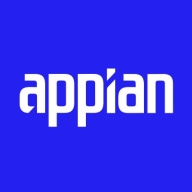

Appian and Comindware Tracker are engaged in a competitive space for business process management. Appian leads with its automation tools that cater to complex enterprise requirements, while Comindware Tracker's customization options make it attractive for businesses prioritizing flexibility.
Features: Appian provides rapid low-code development, robust process design, and seamless integration capabilities, allowing for effective automation and rapid deployment. Comindware Tracker offers no-code configuration, adaptable workflows, and easy synchronization with other tools, promoting process customization without technical expertise.
Room for Improvement: Appian needs to simplify its complex deployment process, improve cost-efficiency, and streamline its interface for non-technical users. Comindware Tracker could benefit from enhancing its mobile app capabilities, expanding third-party integrations, and providing more detailed analytics and reporting tools.
Ease of Deployment and Customer Service: Comindware Tracker features straightforward installation and excellent support, offering ease of setup. Appian, while known for professional support, requires a more involved deployment phase due to its comprehensive nature.
Pricing and ROI: Appian's higher setup costs may lead to significant ROI when fully leveraging its features, suitable for enterprises with complex needs. Comindware Tracker offers a cost-effective model with lower initial expenses and potential high ROI through its flexible system adaptability.
They see return on investment in terms of cost savings, time savings, more efficient processes, and more efficient employees.
Appian is very efficient, allowing us to build a lot of applications within a financial year, making it cost-effective.
The technical support for Appian rates as 10 out of 10 because they have a great support team.
Their customer service is responsive, and the team is very prompt for support.
The technical support is generally good.
On a scale of one to 10, Appian rates as a nine for scalability.
Initially, without much coding, I can easily handle five thousand records.
Appian is scalable, but it depends on how you build your applications.
It depends on how it has been designed and how it has been configured.
The stability of Appian would rate as nine, as it's a stable environment.
It has room to improve for use cases where the users are public facing, where anonymous users could come to a site and run a business workflow or interact with some data.
I would like to see more enhancement in the user interface to allow more freedom in designing the sites and pages.
If there is a very complex process that includes a lot of data transitioning and memory-centric processes, it consumes a lot of memory.
On the pricier side, both Appian and Pega are enterprise-level solutions, placing them on the slightly higher side.
The pricing of Appian is based on the number of users and generally ranges from 70 to 100 USD per user per month.
The price of Appian, on a competitive landscape, is a little bit on the higher side for companies, rating maybe a 6.5.
Appian is aiding in leveraging AI technologies in multiple ways: one way is for developers, as they make development efficient and quick by enabling developer co-pilots across various phases of the application, which helps design Appian quickly and provides suggestions along the way.
The zero-code integration feature is remarkable, allowing for ease of data transfer and workflow enhancement.
It is easy for me to define the process and create configurable workflows.

Appian is a unified low-code platform and solution used by businesses to build enterprise applications and workflows. This product adapts to the needs of clients and the technologies they are already using to combine their data in a single workflow and maximize resources. The platform has four main components through which it transforms the work process for companies of various sizes. They are:
Appian is utilized across a diverse set of industries, including automotive and manufacturing, energy and utilities, education, financial services, telecom and media, transportation, retail, insurance, healthcare, and life sciences. The most frequent use cases of Appian are customer journey, governance, risk and compliance, operational efficiency, supply chain, distributed order management, and environmental, social, and governance (ESG) management.
Appian Features
Appian has various features that allow users to create solutions for their businesses. These features can be separated into a few groups according to function, including automation, low-code application development, and integrations and data. Some of the most frequently used features of Appian include:
Appian Benefits
The benefits of using Appian include:
Reviews from Real Users
A practice leader - digital process automation at a computer software company values Appian highly because the product is easy to develop, low-code, and has a good user interface.
Alan G., an advisory board member at Codecon VR, Appian offers a clear application life cycle, easy to learn documentation, and comes with a fundamentals course.
Non-coding workflow software for business process modelling and management, automation of business operations, and workflow productivity boost. Minimize dependency on IT and allows non-technical users to design, run and modify Workflows with drag-and-drop simplicity.
A wide variety of workflow management solutions have been built with Comindware Tracker across all industries, departments, and workflow scenarios and brought transparency and accountability in businesses.
Key benefits of Comindware Workflow Software:
The Workflow Management system enables non-code addition and modification of workflows with no interruption to ongoing activities. It ensures quick-win implementation and reduces expenses.
We monitor all Business Process Management (BPM) reviews to prevent fraudulent reviews and keep review quality high. We do not post reviews by company employees or direct competitors. We validate each review for authenticity via cross-reference with LinkedIn, and personal follow-up with the reviewer when necessary.